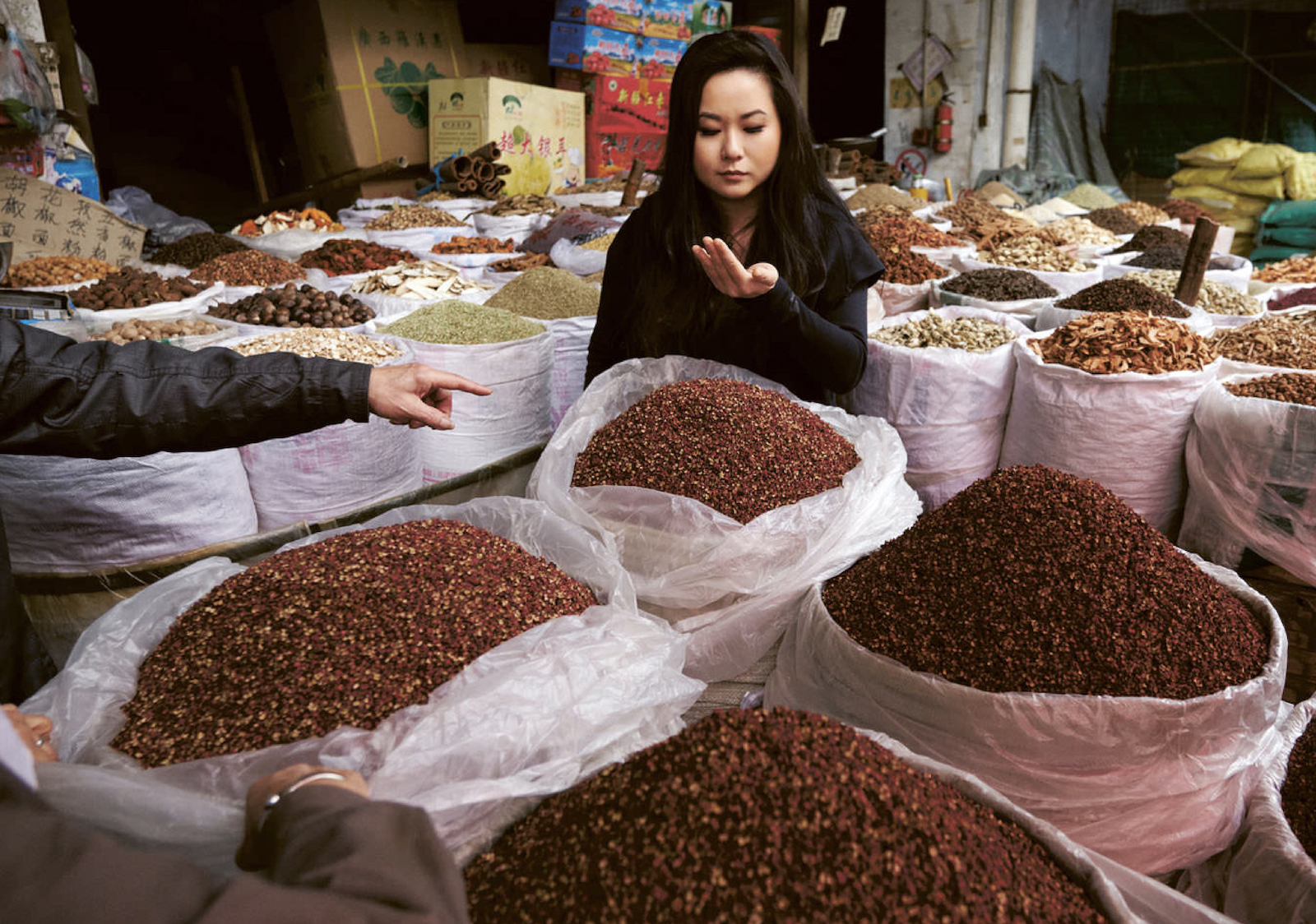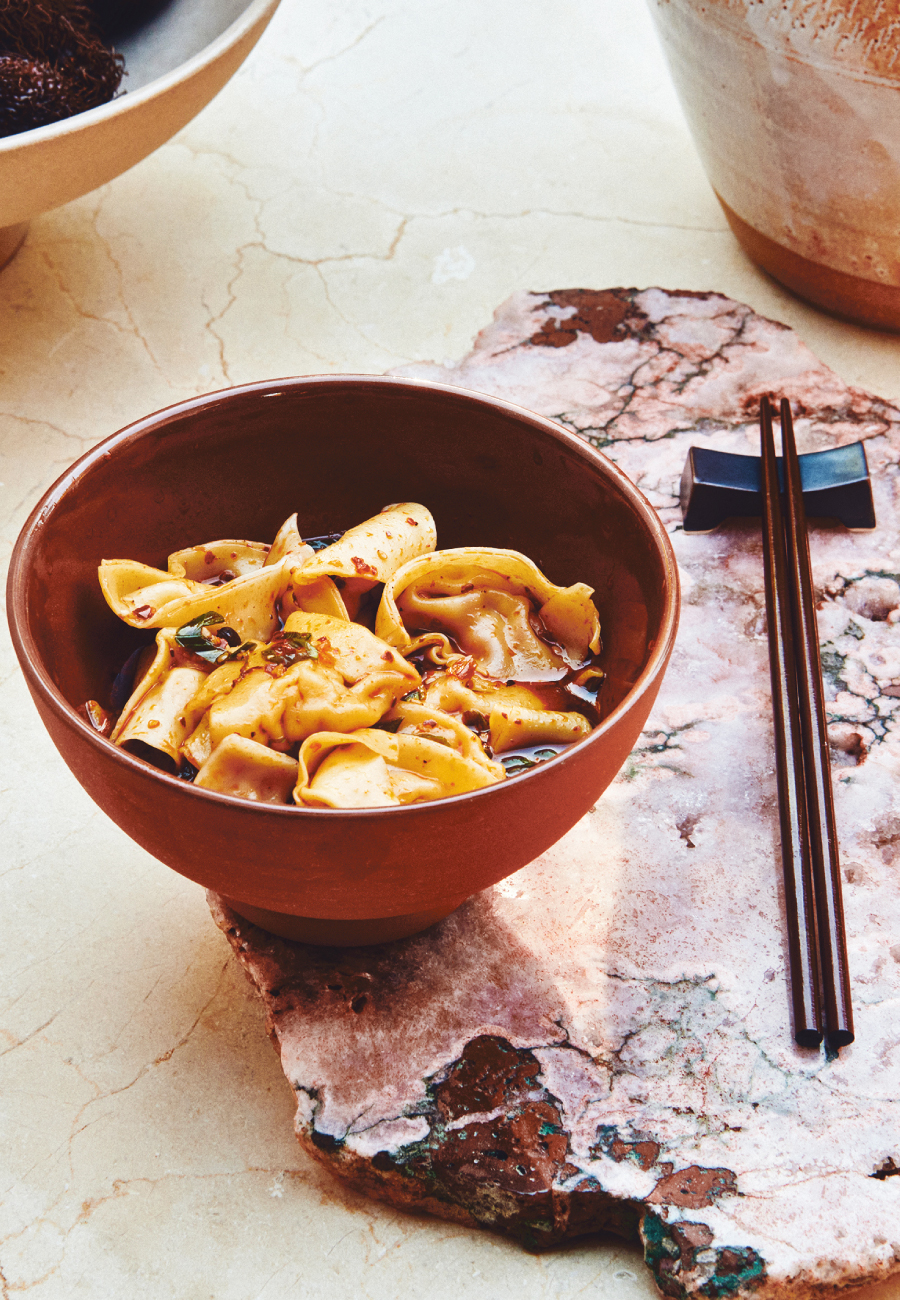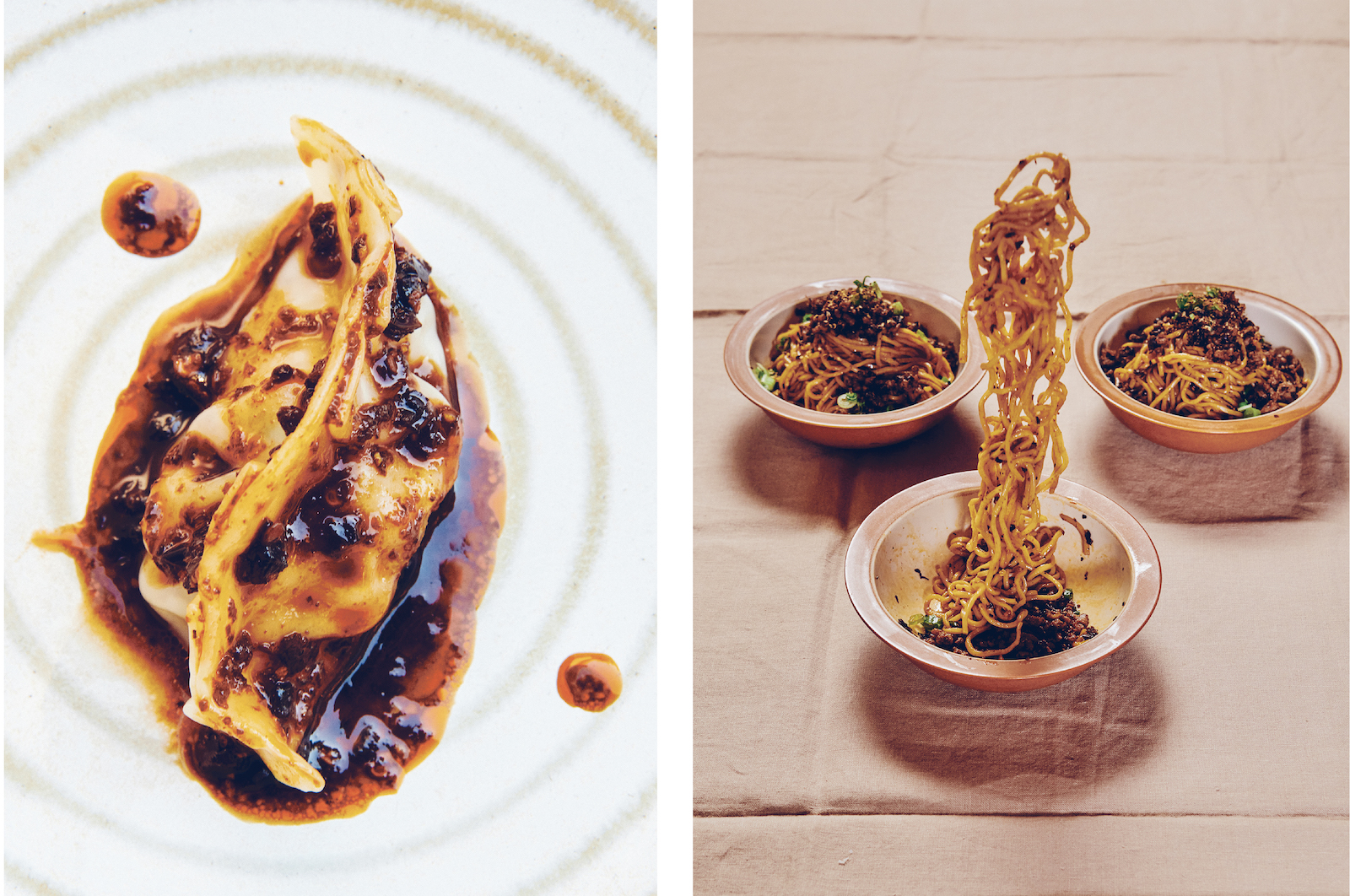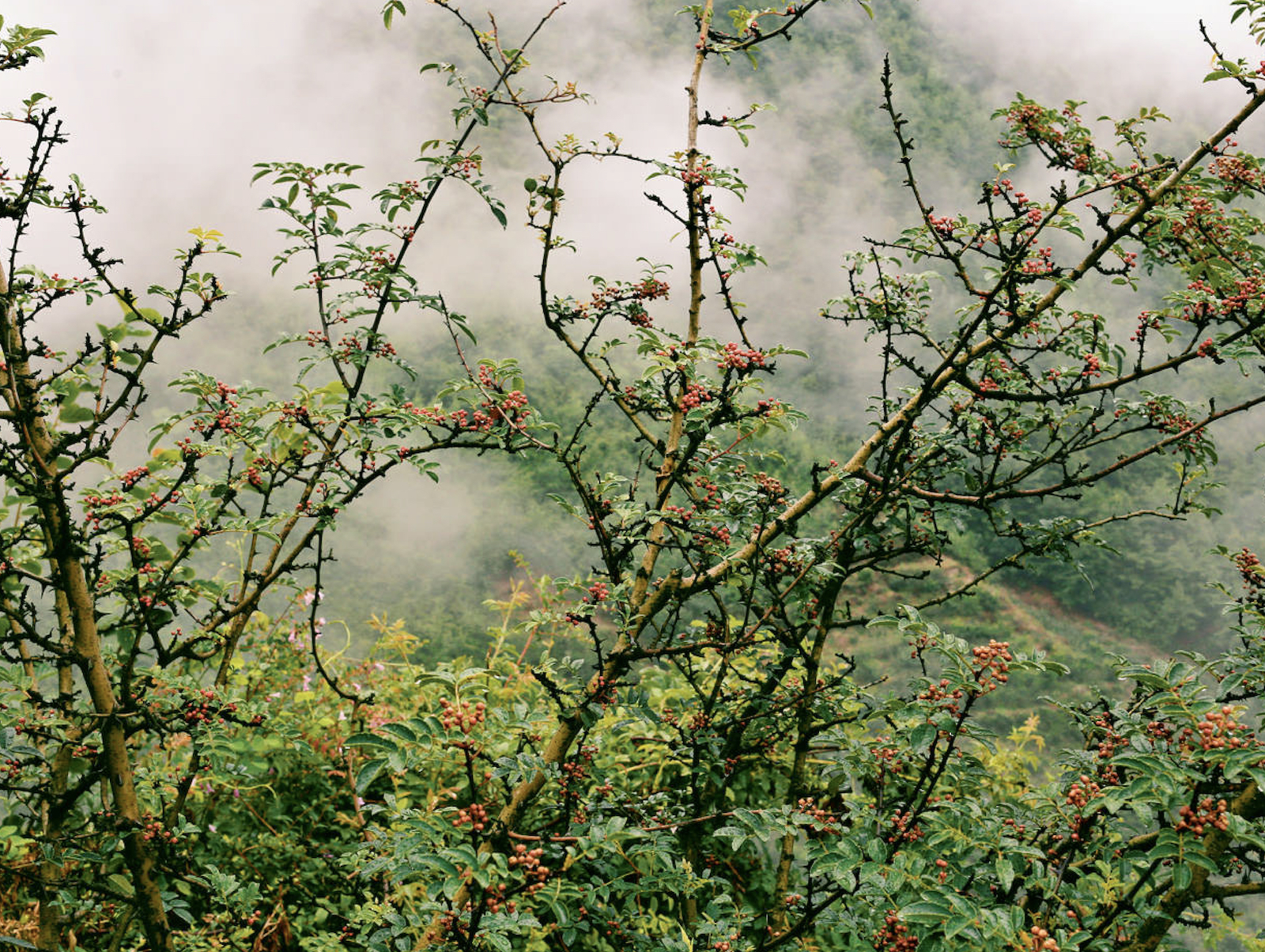August is Jing Gao’s favourite month to travel southwest from Chengdu, along the ancient Tea Horse Road up the precipitous foothills of the Himalayas, where for centuries porters hiked to and fro with tea from the lush mountains of China and ponies from the broad Tibetan highlands. In that month, she says, the air is electric, buzzing through the steaming bamboo forest with a lingering scent of spice and citrus that clings to her clothes and hair. Around the village of Qingxi, the mountainsides are mantled with short, shrubby trees bearing clusters of tiny red fruit. Picked gently by hand at just the right moment, they then crack open to let fall their tiny black seed. The open pods are collected and dried in the sun.
Crunch one of the dried husks between your teeth, and an unusual sensation—unlike any other food on Earth—spreads through your mouth. First a flash of bright fruity aroma and a spicy crack akin to black pepper, and then a growing, humming, numbing tingle. Food writer Harold McGee compares the sensation to touching your tongue to a nine-volt battery. Enterprising scientists at University College London pegged the buzzing feeling at a frequency of 50 hertz, approximately a G-sharp played on a contrabassoon.
“The really fresh ones go beyond the tingle,” Gao says. “There’s fragrance, and a citrusy floral taste as well. It’s quite intoxicating. It’s like a vibration on your tongue. It adds a mouthfeel and a texture to what you’re eating, an added dimension.”

Jing Gao inspects dried Sichuan peppercorns in a market.
This is huajiao, also known as flower pepper, Sichuan pepper, or prickly ash, a plant that gave its flavour to notoriously spicy southwestern Chinese cooking for more than a millennium before the chili pepper arrived from the Americas in the 16th century. In recent centuries, the numbing tingle of Sichuan pepper, ma, and the spicy heat of chili pepper, la, have melded into the most distinctive flavour profile of Sichuan province, mala, a tingly hot dance in which huajiao cools and refreshes the palate to make way for even more spice. The huajiao of Qingxi was once so prized that it was sent directly to the emperor, earning it the title gongjiao, or “tribute pepper.”
Ingredients such as Qingxi gongjiao are precious elements of Gao’s culinary stash, a collection she now shares with the world outside of China through her fine pantry goods company Fly By Jing. For the 36-year-old food writer and restaurateur, it’s one way of burnishing the profile of exceptional Chinese local ingredients that have too often been overlooked.
Gao spent her early years on the outskirts of Chengdu, the capital of Sichuan province, but her father, a university professor, uprooted the family to travel around the world to positions in Germany, England, Austria, France, Italy, and Canada. She graduated from business school in Ontario and hopped among corporate jobs until a posting with BlackBerry sent her back to China. The rediscovery of her home country—and its food—precipitated a sort of identity crisis. “Being in China forced me to realize how divorced I’d become from my roots all those years and how much I had pushed down and buried them, just to be seen, just to survive. I slowly peeled back the layers, and food gave me the courage to do so,” she writes in her new cookbook The Book of Sichuan Chili Crisp. As she dug into the food of her childhood and wrote about it on her blog, she readopted her birth name Jing instead of the anglicized Jenny she had used in school.
The popularity of the blog spun into quitting her day job to open a fast-casual restaurant, Baoism, in Shanghai, and host an underground supper club, travelling from country to country cooking pop-up dinners. But her real interest, she discovered, was not in the hustle of the restaurant industry—it was in ingredients and flavours.
What makes Sichuanese food distinct is its complexity, blending a wealth of spices, sauces, and aromatic plants into 24 flavour profiles.
Sichuan is not the only province of China famous for its spicy food. Rugged Hunan province, to the east, is known for simple, bright peasant food piled with chili peppers, and the people of mountainous Guizhou to the south—home of world-famous Laoganma chili sauce—enjoy a fragrant combination of sour and hot. What makes Sichuanese food distinct is its complexity, blending a wealth of spices, sauces, and aromatic plants into 24 flavour profiles that accompany thousands of dishes. Huajiao, used a tiny pinch at a time, is a harmonizing commonality to many of the favourite foods of Sichuan—an essential balancing tingle that excites the palate.

Chili oil dumplings.
Growing up near Chengdu, Gao had a particular fondness for xiaochi, or “little eats,” dishes a bit more than a snack and less than a meal sold on the street corners or out of ramshackle stalls. Her earliest memories of food are slurping down noodles in pungent broth, dumplings tossed in sweet and spicy soy, and wontons swimming in chili oil. The magic that pulls these foods together is invariably the sauce—hot, fragrant, and tingling. These sauces are the backbone of Fly By Jing, Gao’s company named after what the Sichuanese affectionately call “fly restaurants,” tiny shops with questionable hygiene and irresistible food that attract customers like flies.
After a successful Kickstarter campaign, Fly By Jing picked up $12 million in Series B investment this spring, and the company’s lineup now includes chili oil, chili crisp, dumpling sauce, and carefully sourced chili peppers and huajiao from Sichuan. For Gao, it’s an opportunity to share her cherished Sichuan flavours with a larger audience than she could ever serve at a restaurant.
While the Japanese word umami has spread through the cooking world to the point of cliché, an entire flavour—the Sichuanese ma tingle of huajiao—has still made relatively few inroads outside of Sichuanese cuisine. It’s a sign, Gao says, of how Chinese food has often been sidelined compared to cuisines labelled as more refined.

Left: Zhong dumplings. Right: Dan Dan noodles.
“When we launched in 2018, I think it was a shock to a lot of people that we were charging a premium,” she says. “That respect for provenance of ingredients, the authenticity of sourcing, craft, and artistry, and all of those things, is really reserved for cuisines that we deem of high value, like French or Italian or Japanese, where we’re willing to pay top shelf. Traditionally, Chinese food has been on the lower rungs of that value ladder.”
But that subordination, she believes, is changing. The Chinese condiment chili crisp—celebrated in Gao’s new book—is having an undeniable moment, with small producers and celebrity chefs all selling their unique versions. With popularity comes more attention to the sourcing and quality of individual ingredients. Most Western cooks are familiar with the jealously guarded provenance of cheese from Parma, wine from Champagne, ham from Iberia, and beef from Kobe. Gao hopes that one day erjingtiao chili peppers from Chengdu, aged spicy bean paste from Pixian, black vinegar from Zhenjiang, and tribute peppers from Qingxi will carry the same weight.

Jing Gao in the kitchen.
It’s a goal Gao pursues by sourcing ingredients that speak to the unmistakable geography she grew up in. “We are made in Chengdu,” she says. “We are made using ingredients from 30 minutes from my hometown. It’s a reflection of a time and a place that you can’t replicate using ingredients you find anywhere else.”
All photos courtesy of Penguin Random House Canada. Read more from our Autumn 2023 issue.









